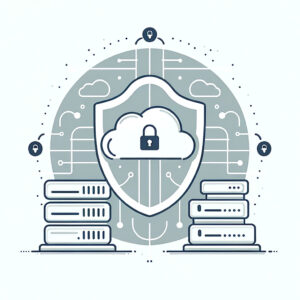Introduction
In the rapidly evolving digital landscape, where every second of downtime translates to lost opportunities, the role of infrastructure monitoring has become more critical than ever. This essential practice, central to the offerings of Kumo Cloud Solutions, encompasses the vigilant oversight of an organization's IT infrastructure, ensuring that every component—be it hardware, network, or applications—operates at its peak performance. By addressing key challenges such as unexpected downtime, performance bottlenecks, and looming security risks, this monitoring stands as a guardian of operational continuity and efficiency.
What is Infrastructure Monitoring?
Breaking Down the Components
Infrastructure monitoring includes several critical elements, each requiring meticulous attention:
- Hardware: The physical backbone of IT operations, including servers, storage systems, and networking equipment. Monitoring focuses on parameters like CPU usage, disk activity, and hardware health indicators.
- Network: This encompasses the data highways connecting various parts of the IT ecosystem. Key metrics include bandwidth utilization, latency, and packet loss, ensuring smooth data flow.
- Applications: The software layer that users interact with directly. Monitoring these components involves tracking error logs, response times, and transaction rates to ensure optimal performance.
Collecting Data
For each component, a variety of data is meticulously collected:
- Hardware data might include temperature readings, fan speeds, and power supply statuses.
- Network monitoring gathers information on traffic patterns, error rates, and connection statuses.
- Application monitoring focuses on user experience metrics like page load times, crash reports, and resource utilization.
Monitoring Methodologies
Diverse methodologies cater to different needs and environments:
- Agent-based monitoring involves installing software on the target systems to gather and relay information.
- Agentless monitoring collects data remotely, minimizing system load but sometimes offering less granularity.
- Cloud-based monitoring provides a flexible and scalable approach, leveraging the cloud to monitor resources anywhere in the world.

Benefits of Infrastructure Monitoring Expanded
Improved Uptime and Performance
Infrastructure monitoring plays a pivotal role in maintaining the highest levels of service availability and performance. By continuously scanning for and identifying potential issues before they escalate, organizations can prevent service disruptions that affect user experience. This proactive approach not only enhances user satisfaction by ensuring applications and services run smoothly but also boosts operational efficiency by maintaining consistent workflow processes. The result is a reliable IT environment where both internal and external stakeholders benefit from uninterrupted service, underpinning the organization's reputation for dependability.
Enhanced Resource Optimization
One of the key advantages of effective monitoring is its ability to highlight areas of resource underutilization. This insight allows IT managers to make informed decisions about reallocating resources to where they are needed most or scaling down resources to save costs without impacting service quality. This level of resource optimization ensures that every bit of the IT infrastructure is being used efficiently, reducing waste and contributing to a more cost-effective operation overall. By aligning resource usage with actual needs, organizations can achieve a leaner, more agile IT infrastructure.
Proactive Security and Compliance
In today's digital landscape, the importance of security and compliance cannot be overstated. Infrastructure monitoring systems are invaluable in their ability to detect suspicious activities and potential vulnerabilities early on. This early detection facilitates prompt action to mitigate risks, thereby protecting the organization from the potentially devastating impacts of security breaches. Moreover, by ensuring systems are running in compliance with relevant standards and regulations, organizations can avoid costly fines and reputational damage, making this monitoring an essential component of any robust security strategy.
Faster Troubleshooting and Root Cause Analysis
The complexity of modern IT environments can make troubleshooting a daunting task. However, with infrastructure monitoring, IT teams have access to detailed, real-time data about their systems. This data can be invaluable in quickly pinpointing the source of a problem, dramatically reducing the time it takes to resolve issues. Faster troubleshooting means less downtime and disruption, directly translating to cost savings and improved operational efficiency. By enabling quick responses to issues, this monitoring ensures that minor problems don't escalate into major crises.
Informed Decision-Making
Monitoring provides a wealth of data, both in real-time and collected over time, which can be analyzed to identify trends and patterns in infrastructure usage and performance. This information is crucial for making informed decisions about when and where to scale resources up or down, invest in new technologies, or optimize existing systems. Decision-makers equipped with accurate, timely data can plan strategic initiatives with greater confidence, ensuring that IT infrastructure evolves in alignment with business goals and market demands. Ultimately, it empowers organizations to make decisions that enhance performance, reduce costs, and drive growth.
Key Considerations for Implementing Infrastructure Monitoring
Choosing the Right Tool
When embarking on the journey of implementing an infrastructure monitoring system, the selection process should not be taken lightly. It's vital to evaluate the spectrum of features each tool offers, from real-time analytics to automated alerting capabilities, ensuring they align with your specific operational landscape. Consider scalability to accommodate future growth, compatibility with your existing tech stack, and, importantly, the cost—balancing budget constraints with the need for a comprehensive solution. This careful assessment guarantees that the chosen system not only meets current requirements but is also a viable long-term investment for the organization.
Defining Metrics and Thresholds
The foundation of effective monitoring lies in pinpointing the precise metrics that matter most to your organization. This involves a detailed analysis to determine key performance indicators such as uptime, response times, and resource utilization rates that directly impact service quality and customer satisfaction. Setting appropriate thresholds for these metrics is equally important; they serve as critical benchmarks that, when breached, trigger alerts. This proactive approach ensures issues can be addressed promptly before escalating, aligning operational performance closely with business objectives and maintaining the integrity of IT services.
Integrating with Other Tools
Achieving a holistic overview of your IT environment's health necessitates a seamless integration between your infrastructure monitoring solution and other management tools within your ecosystem. This integration facilitates the aggregation of data across platforms, enriching the contextual understanding of your infrastructure's performance. Enhanced visibility into system-wide operations enables more coherent and efficient management, allowing for quicker identification of issues and streamlined processes. It's about creating a unified IT management framework where data flows freely, providing a comprehensive view that informs better decision-making and control.
Creating a Monitoring Plan
Crafting a well-structured monitoring plan is akin to drawing a blueprint for sustained IT health. This strategic document should delineate the specific components to be monitored, the frequency of monitoring activities, and the protocols for alert escalation. It's crucial to assign clear responsibilities, ensuring that team members know their roles in the monitoring process and response actions. Establishing such a plan fosters a disciplined approach to infrastructure monitoring, enabling a swift and coordinated response to potential issues. It lays the groundwork for maintaining operational excellence and resilience, ensuring that the IT infrastructure remains robust and reliable.

Conclusion
Infrastructure monitoring is not just a technical necessity but a strategic asset in the modern digital arena. It empowers organizations to maintain high performance, optimize resources, secure data, and make informed decisions. As we've explored the what, why, and how of this monitoring, the path forward is clear: embracing these practices is essential for any organization looking to thrive in today's competitive landscape. For those ready to embark on this journey, countless resources, from detailed guides to professional consultations, are available to guide you through implementing a robust strategy with Kumo Cloud Solutions, California. Let this be your call to action: prioritize monitoring within your IT strategy and watch as it transforms your operations, security, and decision-making capabilities. Call us at (949) 333-1080 for more information.
FAQs
FAQ 1: Can Infrastructure Monitoring Reduce IT Costs?
A: Absolutely! While the primary aim of infrastructure monitoring is to ensure system health and performance, a significant by-product is cost reduction. By identifying and reallocating underutilized resources, and preventing costly downtime and security breaches, organizations can achieve a more efficient use of their IT budgets. This optimization leads to direct savings and a higher ROI on IT investments.
FAQ 2: How Quickly Can Problems Be Detected with Infrastructure Monitoring?
A: Rapid Detection: Infrastructure monitoring operates in real-time, meaning that as soon as an anomaly occurs or a threshold is breached, it can instantly trigger alerts. This immediacy allows IT teams to begin troubleshooting immediately, significantly reducing the time it takes to respond to and resolve issues. The speed of detection and resolution is a core benefit, ensuring minimal impact on operations.
FAQ 3: Is Infrastructure Monitoring Suitable for Small Businesses?
A: Definitely! No matter the size of your business, infrastructure monitoring is crucial. Small businesses, in particular, can benefit from the scalability of such solutions. They provide critical insights into performance and security without the need for extensive IT departments. Tailored solutions mean that even smaller enterprises can enjoy the advantages of enhanced uptime, security, and operational efficiency, leveling the playing field with larger competitors.


You must be logged in to post a comment.